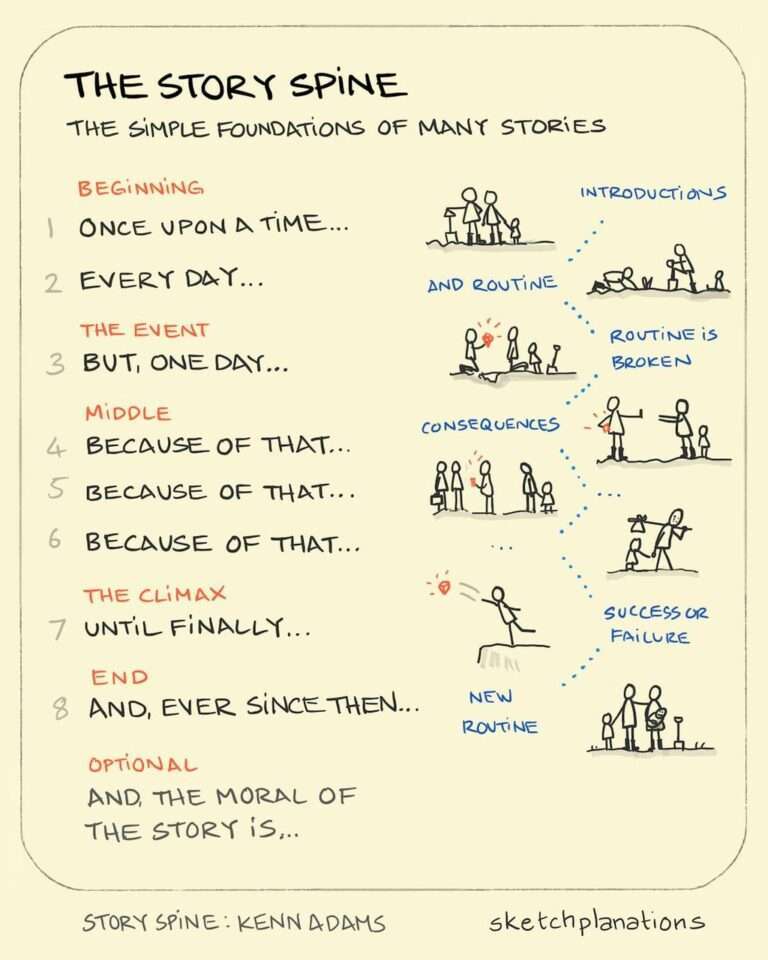The 5 C’s of Storytelling (Circumstance, Curiosity, Characters, Conversations, Conflict): A model focusing on key elements that make a story engaging.
Overview
Introduction
Storytelling is a powerful tool that has been used for centuries to captivate and engage audiences. Whether it’s through books, movies, or oral traditions, stories have the ability to transport us to different worlds and evoke a wide range of emotions. In this article, we will explore the 5 C’s of storytelling: Circumstance, Curiosity, Characters, Conversations, and Conflict. These key elements are essential in creating a compelling narrative that keeps readers hooked from beginning to end. By understanding and implementing these elements in your own storytelling, you can take your writing to the next level and create stories that leave a lasting impact on your audience. So, let’s dive in and discover the secrets of effective storytelling!
Importance of Storytelling
Storytelling is a powerful tool that captivates audiences and leaves a lasting impact. It allows us to connect with others on a deeper level, invoking emotions and creating memorable experiences. Stories have the ability to inspire, educate, and entertain, making them an essential part of human communication. Through storytelling, we can convey complex ideas and messages in a way that is relatable and easily understood. Moreover, stories have the power to shape our beliefs, values, and perspectives, influencing how we see the world. In the realm of business, storytelling is a valuable skill that can help build strong connections with customers, convey brand messages, and drive engagement. By harnessing the 5 C’s of storytelling – Circumstance, Curiosity, Characters, Conversations, and Conflict – we can create compelling narratives that resonate with our audience. Unifire is a platform that empowers storytellers to bring their ideas to life, providing a range of tools and resources to enhance the storytelling experience. Start crafting your own captivating stories with Unifire today!
How to Harness the Power of Storytelling
- Identify your audience: Understand who you are telling the story to and tailor your narrative accordingly.
- Develop a clear message: Define the main idea or theme you want to convey through your story.
- Create compelling characters: Craft relatable and dynamic characters that will engage your audience.
- Build tension and conflict: Introduce obstacles and challenges that drive the plot and keep readers hooked.
- Use authentic dialogue: Write conversations that feel genuine and reveal important information.
- Establish a strong setting: Paint a vivid picture of the world your story takes place in.
- Edit and revise: Polish your story by reviewing and refining it to ensure it flows smoothly.
By following these steps, you can harness the power of storytelling and create narratives that captivate and engage your audience.
Elements of a Compelling Story
A compelling story is built upon several key elements that captivate readers and keep them engaged from beginning to end. These elements include Circumstance, Curiosity, Characters, Conversations, and Conflict. Each of these components plays a crucial role in creating a story that resonates with the audience and leaves a lasting impact. Circumstance sets the stage by establishing the setting, creating a problem, and establishing the context. Curiosity is essential for creating intrigue, piquing the reader’s interest, and building suspense. Characters are the heart of any story, and developing believable characters, exploring character arcs and growth, and building emotional connections are essential for a compelling narrative. Conversations bring the story to life through authentic dialogue, revealing information, and driving the plot forward. Lastly, Conflict creates tension and adds obstacles and challenges that the characters must overcome, leading to a satisfying resolution. By incorporating these elements effectively, storytellers can create a captivating and memorable narrative that resonates with readers. To learn more about storytelling techniques and enhance your storytelling skills, visit Unifire for practical tips and resources. Unifire is a platform dedicated to helping writers and storytellers unleash their full potential and create impactful stories. Check out their website and start your storytelling journey today!
Circumstance
Setting the Stage
Setting the stage is a crucial element in storytelling. It involves creating the backdrop and context for the story to unfold. By carefully crafting the setting, the writer can transport the reader to a specific time and place, immersing them in the world of the story. The setting not only provides a visual image but also sets the tone and atmosphere of the narrative. It helps to establish the mood and create a sense of anticipation. Through vivid descriptions and attention to detail, the writer can engage the reader’s senses and evoke emotions. The setting serves as the foundation upon which the rest of the story is built, influencing the actions and decisions of the characters. It creates a sense of believability and helps to overcome any perceptions of "unrealness". By setting the stage effectively, the writer can captivate the reader from the very beginning and lay the groundwork for a compelling story.
Creating a Problem
In order to create a compelling story, it is crucial to introduce a problem or conflict for the characters to overcome. This problem serves as the driving force behind the story, creating tension and suspense. Good storytellers understand the importance of creating a problem that is relatable and engaging for the audience. By presenting a problem that the characters must face, the storyteller captures the reader’s attention and keeps them invested in the story. Whether it’s a personal dilemma, an external threat, or a moral conflict, the problem should be significant enough to challenge the characters and push them to grow and evolve. This creates a sense of anticipation and keeps the reader engaged as they eagerly await the resolution of the problem. By creating a problem that resonates with the audience and evokes emotions, the storyteller ensures that the story will leave a lasting impact.
Establishing the Context
In order to create a compelling story, it is crucial to establish the context in which the narrative unfolds. This involves providing the necessary background information and setting the stage for the events that will follow. By clearly defining the time, place, and circumstances, the reader can better understand the motivations and actions of the characters. Additionally, establishing the context allows the reader to immerse themselves in the story and connect with the protagonist on a deeper level. Whether it is a historical period, a futuristic world, or a familiar setting, the context plays a vital role in shaping the overall narrative and creating a sense of authenticity. By effectively establishing the context, the storyteller lays the foundation for an engaging and immersive experience for the reader.
To learn more about the other key elements of storytelling, such as circumstance, curiosity, characters, conversations, and conflict, continue reading the article. Discover how each of these elements contributes to the overall success of a story and learn practical tips on how to incorporate them into your own storytelling. Ready to unleash your storytelling skills? Visit Unifire, a platform designed to help creators scale authentic content and leave a lasting impact on their audience. Take your storytelling to the next level and join the movement of Smart Creators who are constantly innovating and pushing the boundaries of quality content.
CTA: Visit Unifire
How to Establish the Context in Your Storytelling:
- Research and gather information about the time period, location, and cultural background of your story.
- Create vivid descriptions that paint a clear picture of the setting and atmosphere.
- Introduce relevant historical or societal events that influence the context of the story.
- Develop believable and relatable characters that are shaped by the context in which they exist.
- Use dialogue and interactions between characters to further establish the context.
- Continuously refer back to the context throughout the story to maintain consistency and enhance the reader’s understanding.
By following these steps, you can effectively establish the context in your storytelling and create a rich and immersive experience for your readers.
Curiosity
Creating Intrigue
Creating intrigue is a crucial element of storytelling that captivates the reader’s attention and keeps them engaged throughout the narrative. By introducing a mystery or unanswered question, you can spark curiosity and compel the reader to continue reading. This can be achieved through the use of foreshadowing, unexpected plot twists, or withholding important information. Additionally, establishing a sense of urgency can heighten the intrigue and create a sense of anticipation. By gradually revealing clues and unraveling the mystery, you can maintain the reader’s interest and ensure they are invested in the story’s outcome. Intrigue is a powerful tool that can make your story more compelling and memorable, so don’t be afraid to take risks and experiment with different techniques to keep your readers on the edge of their seats.
For more tips on creating intrigue and crafting engaging stories, check out Unifire – a platform that provides valuable resources and tools for writers.
How to Create Intrigue in Your Story:
- Establish a mystery or unanswered question early on.
- Use foreshadowing to hint at future events.
- Incorporate unexpected plot twists to keep the reader guessing.
- Withhold important information to create suspense.
- Gradually reveal clues and unravel the mystery.
- Establish a sense of urgency to heighten the intrigue.
- Experiment with different techniques to keep readers engaged.
By following these steps, you can create a captivating and intriguing story that will leave readers wanting more.
Piquing the Reader’s Interest
One of the key insights of this article is the importance of creating intrigue to pique the reader’s interest. To engage readers, storytellers must introduce elements of mystery, suspense, or curiosity that make them want to know more. This can be achieved through foreshadowing, cliffhangers, or unexpected twists. By building suspense and leaving unanswered questions, storytellers can captivate readers and keep them hooked throughout the story. Additionally, building emotional connections between the reader and the characters can also generate curiosity and make the story more compelling. When readers care about the characters and their journeys, they are more likely to be invested in the story and eager to uncover what happens next.
To effectively pique the reader’s interest, it is essential to craft compelling openings that grab their attention from the very beginning. This can be done through vivid descriptions, thought-provoking statements, or intriguing scenarios. By setting the stage and introducing the main conflict or problem early on, storytellers can instantly captivate readers and make them curious about how the story will unfold. Remember, the goal is to create a sense of anticipation and make readers eager to dive deeper into the story.
CTA: Visit Unifire for more storytelling tips and techniques to captivate your audience and create unforgettable narratives.
How to Pique the Reader’s Interest:
- Start with a compelling opening that grabs attention.
- Introduce elements of mystery, suspense, or curiosity.
- Foreshadow future events or unexpected twists.
- Build emotional connections between the reader and the characters.
- Craft vivid descriptions and thought-provoking statements.
- Create a sense of anticipation and leave unanswered questions.
- Keep the main conflict or problem front and center.
- Use cliffhangers to keep readers hooked.
- Experiment with different storytelling techniques to engage readers.
- Continuously refine and revise your story to maintain reader interest.
Building Suspense
Building suspense is a crucial element in storytelling that keeps readers engaged and on the edge of their seats. By gradually revealing information and creating a sense of anticipation, authors can captivate their audience and keep them guessing about what will happen next. One effective technique to build suspense is to withhold key information and slowly unveil it at strategic moments, creating a sense of mystery and intrigue. Another way to build suspense is to create a ticking clock or a sense of urgency, where the characters are racing against time to achieve their goals. Additionally, using descriptive language and vivid imagery can heighten the tension and make the reader feel as if they are right there with the characters, experiencing the suspense firsthand. By mastering the art of building suspense, authors can create stories that leave a lasting impact on their readers.
To learn more about the art of storytelling and how to master the 5 C’s, check out Unifire, a platform that offers comprehensive resources, workshops, and tools for aspiring writers. With Unifire, you can take your storytelling skills to the next level and create captivating narratives that resonate with your audience.
CTA: Visit Unifire today and start your journey towards becoming a master storyteller!
Characters
Developing Believable Characters
One of the key elements in creating a compelling story is developing believable characters. Believable characters are essential for engaging the reader and making them emotionally invested in the story. To develop believable characters, it is important to give them depth and complexity. This can be achieved by creating detailed backstories, exploring their motivations and desires, and showing their growth and development throughout the story. Additionally, character arcs play a crucial role in making characters relatable and interesting. A character arc is the journey a character goes through, where they experience personal growth or change. By giving characters meaningful arcs, the reader can witness their transformation and feel a deeper connection to them. Building emotional connections with the reader is also important. Emotional connections can be established by portraying characters with relatable emotions and experiences, allowing the reader to empathize with them. When readers feel connected to the characters, they become more invested in the story and its outcome.
Creating believable characters is an art that requires careful crafting and attention to detail. By prioritizing depth over high-level explanations, writers can create characters that feel real and authentic. It is important to give characters unique traits, flaws, and strengths, as well as to show their vulnerabilities and struggles. By doing so, the characters become more relatable and human, and the reader becomes more emotionally invested in their journey. Developing believable characters is a crucial aspect of storytelling that can greatly enhance the overall quality and impact of a story.
Unifire is a powerful tool that can help writers in developing believable characters. With its advanced features and resources, writers can easily create well-rounded and compelling characters that resonate with readers. Whether it’s generating character profiles, exploring different personality traits, or brainstorming character arcs, Unifire provides a comprehensive platform for character development. Try Unifire today and take your storytelling to the next level!
How to Develop Believable Characters:
- Start with a detailed character profile: Create a comprehensive profile for each character, including their background, personality traits, and goals.
- Explore character motivations: Understand what drives your characters and what they want to achieve.
- Show character growth: Allow your characters to evolve and change throughout the story, giving them meaningful arcs.
- Build emotional connections: Portray characters with relatable emotions and experiences to establish a strong connection with the reader.
- Give characters strengths and flaws: Make your characters multi-dimensional by giving them both strengths and weaknesses.
- Show vulnerabilities and struggles: Characters who face challenges and overcome obstacles are more compelling and relatable.
- Use dialogue effectively: Dialogue can reveal a character’s personality and provide insights into their thoughts and feelings.
By following these steps, you can create believable characters that captivate your readers and bring your story to life.
Character Arcs and Growth
When it comes to creating compelling stories, one of the key elements to focus on is character arcs and growth. Character arcs refer to the transformation and development that a character undergoes throughout the story. This is essential for creating depth and emotional connections with the audience. A well-crafted character arc allows the reader to witness the growth, challenges, and changes that the character experiences, making the story more engaging and relatable. By prioritizing character development, authors can create multidimensional characters that resonate with readers. Additionally, exploring themes of growth and personal transformation adds depth and complexity to the narrative. Whether it’s a hero’s journey or a coming-of-age story, character arcs and growth play a crucial role in captivating the audience and keeping them invested in the story.
CTA: If you’re looking to enhance your storytelling skills and create captivating character arcs, check out Unifire. Unifire is a platform that helps content creators scale authentic content and turn their ideas into impactful stories. With Unifire, you can unlock your creative potential and take your storytelling to the next level.
How to: To create compelling character arcs and growth in your stories, consider the following steps:
- Establish a starting point: Introduce your character and establish their initial state or situation.
- Identify the character’s desires and goals: What does the character want to achieve or overcome?
- Introduce conflict and obstacles: Create challenges and obstacles that the character must face in order to grow.
- Show the character’s journey: Take the reader on a journey of growth, showcasing the character’s development, setbacks, and triumphs.
- Highlight internal struggles: Explore the character’s inner conflicts and emotions, allowing the reader to connect on a deeper level.
- Provide resolution and transformation: Wrap up the character arc by showing how the character has changed and grown as a result of their experiences.
By following these steps, you can create compelling character arcs that keep readers engaged and invested in your story.
Conversations
Dialogue and Authenticity
In the realm of storytelling, dialogue plays a crucial role in bringing characters to life and driving the plot forward. Authentic and well-crafted dialogue not only adds depth to the narrative but also helps in revealing important information and creating a sense of realism. By using realistic and natural language, writers can captivate readers and make them feel like they are part of the conversation. Moreover, dialogue can be used to showcase the unique personalities of the characters and their emotions, building a stronger emotional connection with the audience. To ensure authenticity, it is important to pay attention to the tone, speech patterns, and vocabulary used by each character, making sure they align with their background and personality. By mastering the art of dialogue, storytellers can create engaging and memorable interactions that keep readers hooked until the very end.
If you’re looking to enhance your storytelling skills and create authentic dialogue, consider using Unifire. Unifire is a powerful tool that can help you transform your ideas into compelling content. With its AI-powered features, Unifire can assist you in generating realistic and captivating dialogue that resonates with your audience. Don’t miss out on the opportunity to take your storytelling to the next level with Unifire!
How to Create Authentic Dialogue:
- Know Your Characters: Develop a deep understanding of your characters’ backgrounds, personalities, and motivations. This will help you create dialogue that is true to their individual traits.
- Listen to Real Conversations: Pay attention to how people talk in real life. Observe their speech patterns, use of slang, and non-verbal cues. Incorporate these elements into your dialogue to make it more authentic.
- Read Dialogue-Driven Books and Scripts: Study the work of master storytellers who excel in crafting dialogue. Analyze their techniques and learn from their examples.
- Edit and Refine: After writing your dialogue, revise it multiple times to ensure it flows naturally and serves its purpose in advancing the story.
By following these steps and utilizing the power of Unifire, you can create dialogue that is not only authentic but also captivating, taking your storytelling to new heights.
Revealing Information
One of the key elements of storytelling is the art of revealing information. It is through the strategic unveiling of details that the reader becomes more engaged and invested in the story. By carefully choosing when and how to disclose important information, you can create suspense, intrigue, and a sense of anticipation. Revealing information can be done through dialogue, inner thoughts, or even through the actions and reactions of the characters. It is important to strike a balance between providing enough information to keep the reader interested, while also leaving room for discovery and surprise. By mastering the skill of revealing information, you can captivate your audience and keep them eagerly turning the pages.
To effectively reveal information in your storytelling, consider the following techniques:
- Dramatic Irony: Create situations where the reader knows something the characters do not, adding tension and anticipation.
- Foreshadowing: Hint at future events or revelations, building anticipation and curiosity.
- Flashbacks: Use flashbacks to provide backstory and reveal important information that shapes the current narrative.
- Cliffhangers: End chapters or sections with unresolved questions or mysteries, compelling the reader to continue.
By employing these techniques, you can master the art of revealing information and create a truly engaging and immersive storytelling experience.
CTA: Visit Unifire to explore more about the art of storytelling and discover tools and resources to enhance your storytelling skills.
Driving the Plot Forward
Once you have established authentic and engaging dialogue between your characters, it is important to utilize these conversations to drive the plot forward. Dialogue serves as a powerful tool for revealing essential information about the story, the characters, and their motivations. By strategically placing conversations at key moments, you can create tension, build suspense, and propel the narrative towards its climax. Additionally, authenticity in dialogue is crucial to maintaining the reader’s immersion in the story. The conversations should feel natural and true to the characters, allowing the reader to fully engage with their journey. Through effective use of dialogue, you can effectively advance the plot, deepen the conflict, and keep the reader hooked until the very end.
To further enhance the driving force of the plot, it is important to reveal information gradually and strategically. Revealing information at the right time can create intrigue and keep the reader curious about what will happen next. By carefully selecting which details to disclose and when to disclose them, you can maintain a sense of mystery and anticipation throughout the story. This can be achieved through subtle hints, foreshadowing, or even shocking revelations. The key is to find the perfect balance between revealing enough information to keep the reader engaged, while still leaving room for surprises and unexpected twists.
Finally, conflict plays a crucial role in driving the plot forward. Conflict can take many forms, whether it’s internal struggles within the characters, external obstacles they must overcome, or clashes between characters with opposing goals. By introducing and escalating conflict, you create tension and raise the stakes for your characters. This not only keeps the reader invested in the story, but also provides opportunities for growth and development for the characters. Conflict drives the plot forward by forcing the characters to make choices, face challenges, and ultimately resolve the conflict in a satisfying way.
In conclusion, driving the plot forward is essential for creating a captivating and engaging story. Through authentic dialogue, strategic information reveals, and well-crafted conflict, you can keep the reader hooked and eager to find out what happens next. The key is to carefully balance these elements and use them to propel the narrative towards its resolution.
Ready to unleash the power of storytelling? Visit Unifire to discover how their innovative tools can help you craft compelling narratives that captivate your audience.
How to Drive the Plot Forward:
- Develop authentic and engaging dialogue between characters
- Strategically reveal essential information to maintain intrigue
- Introduce and escalate conflict to raise stakes and create tension
- Balance these elements to keep the reader hooked
- Visit Unifire for tools and resources to enhance your storytelling skills.
Conflict
Creating Tension
Creating tension is a crucial element in storytelling that keeps readers engaged and invested in the narrative. By introducing obstacles and challenges for the characters to overcome, the tension builds, creating a sense of anticipation and excitement. This multilevel lens of tension can be achieved through various means, such as conflicting goals, external threats, or internal struggles. The key is to establish stakes and consequences that make the resolution of the conflict meaningful. Tension drives the plot forward, propelling the story towards its climax and resolution. It keeps readers on the edge of their seats, eager to see how the characters will navigate the challenges they face. Through skillful storytelling, the writer can maintain a balance between escalating tension and providing moments of relief, keeping the audience captivated until the very end.
Obstacles and Challenges
When it comes to storytelling, one of the key obstacles and challenges is creating tension. Tension is what keeps readers engaged and invested in the story. It can be achieved through various means, such as introducing conflicts, raising stakes, and creating obstacles for the characters to overcome. By presenting challenges and obstacles, the story becomes more dynamic and the readers become more emotionally invested. These obstacles and challenges serve as opportunities for the characters to grow and for the plot to progress. They open up spaces for character development, conflict resolution, and ultimately, a satisfying resolution. Overcoming obstacles and challenges is what drives the story forward and keeps the readers hooked.
Resolving Conflict
Resolving conflict is a crucial element in storytelling as it provides closure and satisfaction to the audience. It is the point where the tension built throughout the narrative reaches its peak and is ultimately resolved. This resolution can come in various forms, such as the protagonist overcoming their internal struggles, defeating the antagonist, or finding a compromise. The resolution of conflict allows for character growth and development, as well as the opportunity to tie up loose ends and provide a sense of fulfillment. It is through the resolution of conflict that the story comes to a satisfying conclusion, leaving the reader with a sense of closure and a deeper understanding of the characters and their journey.
Conclusion
Summary
In summary, the 5 C’s of storytelling – Circumstance, Curiosity, Characters, Conversations, and Conflict – are key elements that make a story engaging. By setting the stage and creating a problem in the Circumstance phase, the storyteller grabs the reader’s attention and establishes the context. Curiosity is then sparked by creating intrigue, piquing the reader’s interest, and building suspense. Characters play a crucial role in storytelling, with believable characters, character arcs, and emotional connections captivating the audience. Conversations drive the plot forward through authentic dialogue, revealing information, and adding depth to the story. Conflict adds tension and challenges, creating obstacles for the characters to overcome. Resolving conflict brings closure to the story. Storytelling is a powerful tool that allows us to connect with others on a deeper level and evoke emotions. It is a skill that can be honed and mastered, and its impact should not be underestimated.
CTA: Check out Unifire for more storytelling resources and tips!
To become a better storyteller, it is important to practice and develop your storytelling skills. Here are some practical tips:
- Immerse yourself in storytelling: Read books, watch movies, and listen to podcasts to study different storytelling techniques and styles.
- Study the works of master storytellers: Analyze the storytelling techniques used by renowned authors and filmmakers to understand what makes their stories compelling.
- Experiment with different storytelling techniques: Try using different narrative structures, points of view, and writing styles to find your unique voice as a storyteller.
- Seek feedback: Share your stories with others and ask for constructive feedback. This will help you identify areas for improvement and refine your storytelling skills.
- Practice storytelling in different formats: Explore storytelling through various mediums such as written stories, oral storytelling, or visual storytelling.
By following these tips and continuously honing your storytelling skills, you can become a master storyteller who captivates and engages your audience.
The Power of Storytelling
Storytelling is a powerful tool that has the ability to captivate and engage audiences. It allows us to connect on a deeper level, evoke emotions, and convey important messages. Through storytelling, we can transport readers to different worlds, introduce them to compelling characters, and take them on unforgettable journeys. Stories have the power to inspire, educate, and entertain. They can spark curiosity, ignite imagination, and leave a lasting impact. Whether it’s in books, movies, or even everyday conversations, storytelling has the ability to create meaningful connections and shape our understanding of the world. In a world filled with information overload, storytelling stands out as a way to cut through the noise and truly connect with others. It is a skill that can be honed and mastered, and when used effectively, it can leave a lasting impression. Discover the power of storytelling and unlock your ability to create compelling narratives that resonate with your audience.
CTA: Visit Unifire to learn more about how you can enhance your storytelling skills and create impactful content.
How to Enhance Your Storytelling Skills:
-
Understand the Elements: Familiarize yourself with the key elements of storytelling, such as circumstance, curiosity, characters, conversations, and conflict. These elements form the foundation of a compelling story.
-
Study Successful Stories: Read books, watch movies, and analyze successful stories to understand what makes them engaging. Pay attention to the plot structure, character development, and use of dialogue.
-
Practice Storytelling Techniques: Experiment with different storytelling techniques, such as using descriptive language, creating suspense, and building emotional connections with your audience.
-
Seek Feedback: Share your stories with others and seek feedback. Listen to their perspectives and learn from their insights. Use this feedback to improve your storytelling skills.
-
Embrace Authenticity: Be true to yourself and your unique voice. Authenticity is key in storytelling, as it allows you to connect with your audience on a genuine level.
-
Keep Learning and Growing: Storytelling is a lifelong journey of learning and growth. Stay curious, explore new ideas, and continue to expand your storytelling repertoire.
By mastering the art of storytelling, you can create narratives that leave a lasting impact and resonate with your audience. Start your storytelling journey today and unleash your creative potential.
Final Thoughts
In conclusion, the 5 C’s of storytelling – Circumstance, Curiosity, Characters, Conversations, and Conflict – are essential elements that make a story engaging. By carefully crafting the circumstance and setting the stage, creating curiosity and suspense, developing believable characters with emotional connections, driving the plot forward through authentic conversations, and introducing conflict and resolving it, storytellers can captivate their audience and create a memorable experience. Storytelling has a long history of captivating audiences and has the power to inspire, entertain, and educate. As a writer, it is important to prioritize depth over high-level explanations and to be comprehensive when exploring these key elements. If you want to enhance your storytelling skills, consider trying out Unifire, a powerful tool that can help you create compelling narratives. With Unifire, you can easily structure your story, analyze its effectiveness, and make improvements. Start your storytelling journey today and unleash your creative potential!
In conclusion, Unifire is the perfect tool to extract summaries, keywords, and titles from your podcast and repurpose your content. With Unifire, you can save time and effort by automating the process of generating valuable content. Start using Unifire today and take your content creation to the next level!







